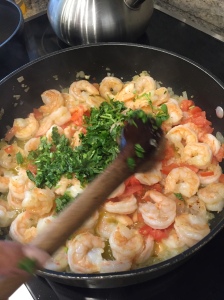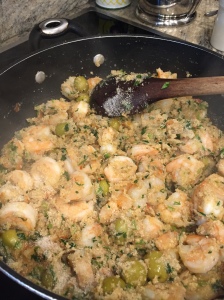My Aunt Neide is an expert when it comes to fish. She and my mom grew up in a town whose river abounded with fish back in their day. Since then, the Sao Francisco river has been the victim of human-inflicted destruction. The river’s waters were diverted for irrigation, damns have been built at various points and deforestation has ripped away the protection from erosion offered by trees. There’s a very good soap opera currently on Brazilian TV. The name is “Velho Chico”. “Chico” is short for Francisco. “Velho” means old. Old Chico is a story about generations of families living along the Sao Francisco river and how the river and life on it has changed over time. If you want to see the beauty of life along the river and the unfolding of a love story, subscribe to Globo TV or wait and watch it when it comes on Spanish TV.
My aunt gets credit for this recipe. My brothers get credit for catching the fish. It’s a Mutton Snapper and was caught off the coast of Florida. My mom says my brothers took after their great-grandmother, Oliva, because they love to fish. She fished on the Sao Francisco river, never missing a day. I personally like the stuffing the most. But why don’t you try for yourself and decide?
Choose a whole fish that has been de-scaled, thoroughly cleaned, rinsed and patted dry. Rub the inside and oustide of the fish with a salt rub made with salt, saffron, garlic and saffron. Place the fish on a cutting board or long tray. Squeeze lime on the fish and set aside for at least 30 minutes. Stuff the fish with the stuffing shown below. Sew the fish closed or use broken skewer sticks to contain the stuffing.
Place the fish on na oven-proof baking pan. Pour olive oil over both sides of the fish and dredge in breadcrumbs. Place in the oven and bake at 375F. While the fish bakes, baste it occasionally with it’s own liquid. After baking you can carefully transfer the fish to a nice serving platter and adorn with cooked shrimp, lettuce leaves, and black olives.
Stuffing: Heat olive oil and garlic in a large saute pan. Add chopped onions and cook until softened. Add the shrimp and cook until pink. Add chopped tomatoes, parsley or cilantro, fresh chili pepper, salt and green olives. Lower the heat and add one heaping tablespoon butter and add the bread crumbs. You can add a little white wine or water to moisten the stuffing. You can also add black olives and chopped hard boiled eggs to the stuff for added taste.
———————————————–
Escolha um peixe inteiro. Depois de escamado, limpo e bem lavado, esfregue bem o peixe com uma miscelânea de temperos socados com sal; ponha numa travessa, regue-o com caldo de limão e deixe repousar por algum tempo: nunca menos de meia hora. Encha então a barriga do peixe com o recheio abaixo. Costure ou feche com palitos de espeto.
Arrume o peixe num tabuleiro de forno, regue com azeite e passe farinha de pão nos dois lados. Ponha no forno pré-aquecido para assar. Enquanto assa deve, de vez em quando, rega-lo com um pouco do próprio molho, que se vai retirando da assadeira.
Depois de assado, coloque o peixe com cuidado numa travessa bonita e guarneça com camarões cozidos, pepinos em conserva, folhas de alface, ramos de agrião e azeitonas pretas.
Recheio:
Faça o recheio com um punhado de camarões, que se refogam com azeite, cebola, alho, tomate, salsa ou coentro, sal, pimenta, se gostar azeitonas verdes; Depois de feito o refogado de camarões tire a caçarola do fogo, junte uma colher de manteiga de lata e misture farinha de mandioca. Se quiser use um pouco de vinho ou agua para umedecer a farinha, azeitonas pretas e ovos cozidos adicionados ao recheio, tornam-no mais rico e saboroso.



